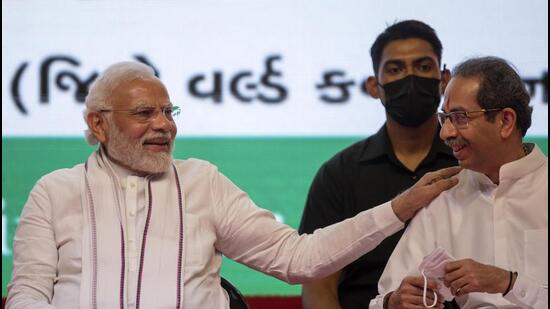Divided by politics, united by languages: Modi, Thackeray point to deep ties between Gujarati and Marathi
Mumbai Amid the hostility between the Centre and Maharashtra, there was a rare display of bonhomie at an event in the city on Tuesday where prime minister Narendra Modi and chief minister Uddhav Thackeray shared the dais
Mumbai

Amid the hostility between the Centre and Maharashtra, there was a rare display of bonhomie at an event in the city on Tuesday where prime minister Narendra Modi and chief minister Uddhav Thackeray shared the dais. While Modi called Mumbai and Maharashtra the maika (maternal home) of Gujarati language, Thackeray pointed to the deep ties between Gujarati and Marathi.
The PM, who briefly spoke in Gujarati before switching to Hindi, said keeping in mind the importance of regional languages, the National Education Policy had given the option to students to choose their mother tongue to pursue their career in medicine or engineering. “A girl or boy from a village can complete standard XII, study medicine in Gujarati, and become a doctor.”
Speaking in Marathi, Thackeray said, “I have love for the Gujaratis. I can understand the language but can’t speak it. Since you all are applauding it means you understand Marathi. Gujarati and Marathi have deep ties; both have mixed in Maharashtra like sugar in milk. I hope that ties become stronger in the future.”
Leader of the opposition in the assembly Devendra Fadnavis and Governor Bhagat Singh Koshyari were also present at the bicentennial anniversary celebration of Mumbai Samachar, a Gujarati daily published from the city.
The statements by Modi and Thackeray are significant as Shiv Sena is attempting to woo the Gujarati, Jain and Marwadi communities, which are largely the vote bank of the Bharatiya Janata Party, ahead of the Brihanmumbai Municipal Corporation elections.
Modi also released a postal stamp to commemorate the occasion. Speaking about the newspaper that has been published since 1822, he said the language was definitely Gujarati, but the approach was national. “Therefore, on this occasion, we are not only celebrating the high standards of journalism in India and the journalism related to patriotism, but this event is also adding to the Azadi ka Amrit Mahotsav.”
Earlier in the day, Modi inaugurated the Jal Bhushan building and the ‘gallery of revolutionaries’ at Raj Bhavan. Thackeray was also present at the event.
The gallery was a bunker, which the British used to store arms and ammunition. It was discovered in 2016 when C Vidyasagar Rao was Governor. In 2019, it was renovated and converted into a museum to commemorate the contributions of freedom fighters and revolutionaries from Maharashtra.
“This place will serve as an educational centre for all people. This bunker which was used to store arms to kill Indians has now the names of all the freedom fighters,” the PM said.
The gallery offers tributes to the contributions of Vasudev Balwant Phadke, the Chapekar brothers, the Savarkar brothers, Madam Bhikaji Cama, VB Gogate, and the Naval Mutiny in 1946, among others.
Modi commended Maharashtra, calling it a cradle of freedom fighters and social reformers. “Maharashtra led the way as it inspired people. It is the birth place of Saint Tukaram as well as Dr Babasaheb Ambedkar.”
Stay updated with all the Breaking News and Latest News from Mumbai. Click here for comprehensive coverage of top Cities including Bengaluru, Delhi, Hyderabad, and more across India along with Stay informed on the latest happenings in World News.
Stay updated with all the Breaking News and Latest News from Mumbai. Click here for comprehensive coverage of top Cities including Bengaluru, Delhi, Hyderabad, and more across India along with Stay informed on the latest happenings in World News.





